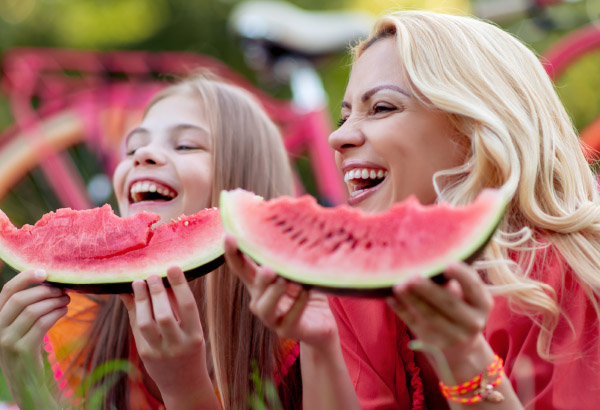
The Wonders of Watermelon
Watermelon is perhaps the most iconic symbol of summer found on a picnic table. This refreshing and succulent summer fruit is a mainstay of summer snacking, but it has several health benefits, too.
It’s low in calories, at about only 80 per two cups. Because 92% of a watermelon’s weight is water, it’s an especially good snack choice if you’re trying to maintain your weight.
Nutritionally, watermelon is a powerhouse, containing many essential vitamins and minerals, including vitamins A, B6, and C, potassium, magnesium, thiamin and phosphorus. Watermelon contains higher levels of lycopene than any other fresh fruit or vegetable (12.7 mg per 2-cup serving) and is part of a healthy diet.
One little known fact about watermelon is that it’s a type of berry; another is that both the rinds and seeds are edible. For example, the seeds can be eaten plain or roasted, and the rind can be pickled or used in stir-fries.
Here are a few tips for choosing a watermelon. A yellow underside indicates ripeness – not to be confused with a yellow watermelon. Also, you’ll hear a hollow sound when you rap on the outside of the melon if it’s ripe.
Many people prefer eating watermelon as is, in slices or cubes – or as part of a nourishing summer fruit salad. But watermelon is a pretty multifunctional fruit and can absorb many flavors. Try sprinkling salt on it or heating it up with spicy pepper.
Watermelon can also be the basis for a delicious smoothie, parfait or ice cream float. Try infusing water with cut-up watermelon or concoct a refreshing watermelon spritzer cocktail. Toss watermelon in a poke bowl, grain salad, or give it a starring role in homemade salsa or a fruit pizza dessert. And there’s nothing like eating frozen watermelon balls on a hot summer day.
No matter how you slice it, watermelon is a nutrient-dense, heart-healthy specimen of summer deliciousness that’s as delectable as it is versatile.


